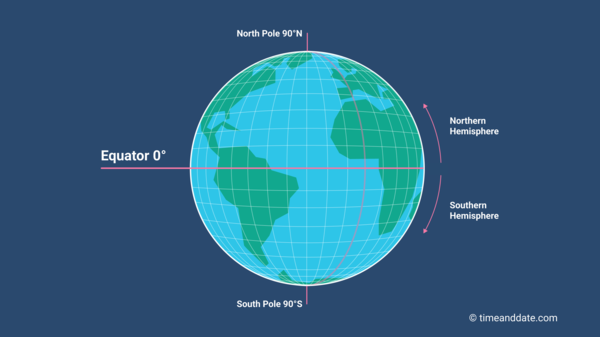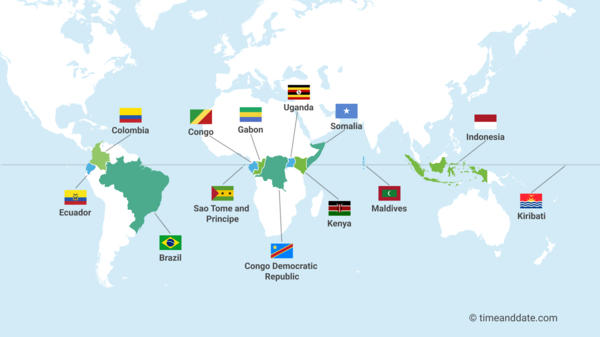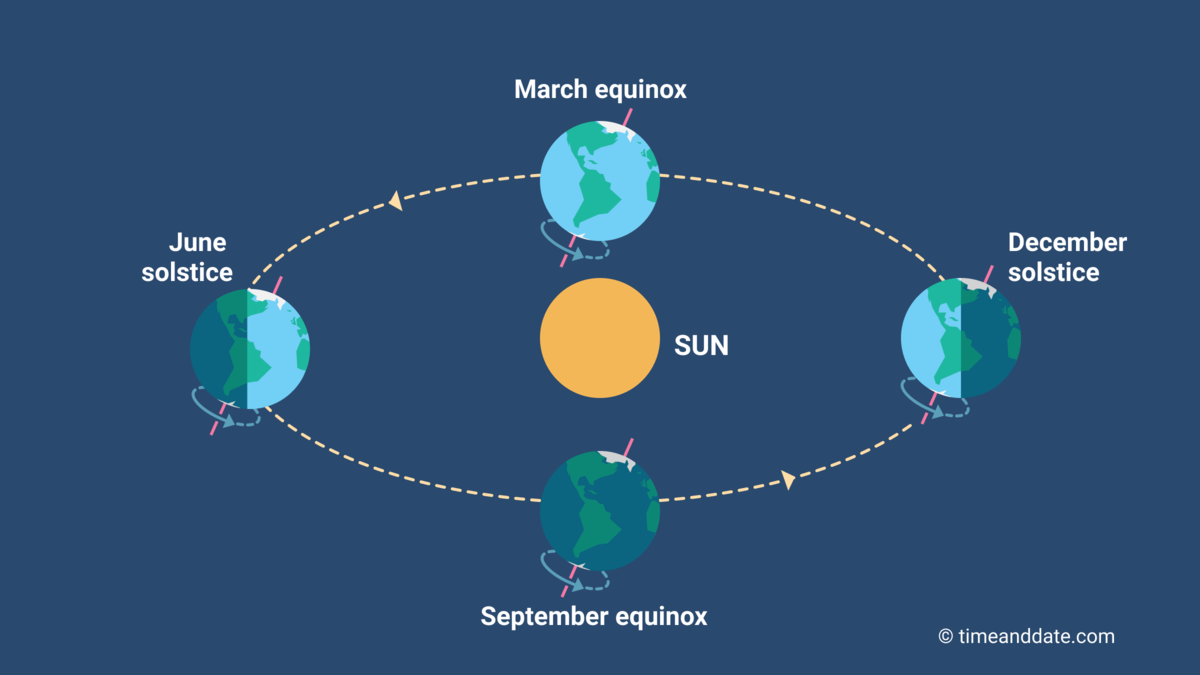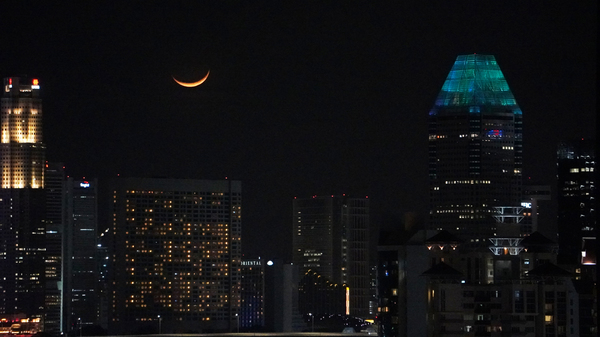The Equator Divides Earth in Two
The equator is an imaginary line between the Northern and Southern Hemispheres. It divides the globe in half at 0 degrees latitude.


The equator is an imaginary line that divides the globe in half at 0° latitude.
©timeanddate.com
What is the Equator?
The equator is an imaginary line dividing Earth into the Northern and Southern Hemispheres. It is located halfway between the North and South poles.
The equator is 40,075 kilometers (24,901 miles) long. Earth isn’t a perfect sphere. Because of its spin, it bulges slightly at the equator. This makes Earth’s circumference at the equator longer than its circumference at the poles.
13 Countries Along the Equator
The equator passes through 13 countries:
Longitude and Latitude
We use a grid of lines known as latitude and longitude to map the Earth’s surface.
Circles of latitude wrap around the planet from east to west, while lines of longitude go from north to south.
Earth’s equator is at 0 degrees latitude and intersects with the Prime Meridian at 0 degrees longitude.
- Ecuador
- Colombia
- Brazil
- Sao Tome and Principe
- Congo
- Gabon
- Congo Democratic Republic
- Uganda
- Kenya
- Somalia
- Maldives
- Indonesia
- Kiribati
11 of the countries are in direct contact with the equator, while it runs through the territorial waters of Kiribati and the Maldives.


The equator runs through 13 countries.
©timeanddate.com
No Traditional Seasons
Countries along the equator don’t have traditional seasons like spring, summer, fall (autumn), and winter. Generally speaking, regions around the equator have wet and dry seasons.
The Northern and Southern Hemispheres tilt toward and away from the Sun at opposite times of the year. This tilt of Earth’s axis is known as axial tilt and is the reason why we have seasons in the north and south of Earth.
The weather at the equator isn’t affected by the axial tilt. There, the Sun’s roughly directly above every day, giving stable and warm temperatures year-round. However, like in the rest of the world, local differences occur, and factors other than the longitude determine the climate and weather.


Earth is tilted towards the Sun, which gives us seasons in the north and south. At the equator (the middle of the globe), the amount of sunlight received is roughly the same throughout the year.
©timeanddate.com
The Sun’s Movement Across the Sky
The Celestial Equator
Imagine Earth’s equator extending into space. This is the celestial equator: an imaginary circle dividing one celestial sphere from another at an equal distance from the poles.
The word equator is derived from the medieval Latin aequator, from the phrase circulus aequator diei et noctis, meaning ‘circle equalizing day and night,’ and from aequare, which means ‘make equal.’
Around the equator, the Sun–more or less– rises vertically and passes directly overhead.
Twice a year, on the March and September equinox, the Sun passes precisely over the equator. This means that when the Sun is at its highest point in the sky, known as the zenith, it will be directly overhead.
At that perfect time of the equinox–when the Sun is both directly overhead and at its highest in the sky–the shadows of everything on the ground disappear!
If you can picture yourself standing on the equator with the Sun directly above on the day of the equinox, you’d have only a tiny sliver of your shadow beneath you.
The only reason there will be ‘some’ shadow is that our bodies are uneven, but if you set up a long and even pole, the Sun would shine directly at the top, and the pole wouldn’t make a shadow at all.
Equal Day and Night
Day and night are approximately the same length along the equator: around 12 hours of daytime and 12 hours of nighttime. However, the days are a few minutes longer than the night.
There are two reasons why the day is a few minutes longer than the night:
- How sunrise and sunset are defined: Sunrise is defined as the moment the top edge of the Sun’s disk appears above the horizon, and sunset is when the last bit of the disk’s edge vanishes below the horizon.
- Atmospheric refraction: Earth’s atmosphere bends the light from the Sun, making it appear higher than its actual position on the horizon.
Equilux: Day and night the same

Moonsmile: A Waxing Crescent Moon setting like a smile over downtown Singapore.
©iStockphoto.com/Pradnya Paithankar
Moon Phases Look Different
We are all looking at the same Moon, but the most apparent difference between the hemispheres is the orientation of the lit-up side of the Moon as it goes through its phases.
The Moon Smiles
At the equator, the bottom sliver of the Waxing Crescent Moon is illuminated, and the Moon sets as a smile just after sunset.
The Waning Cresent Moon rises as a smile before sunrise.
The First Quarter Moon rises about midday, tagging behind the Sun. At the equator, the Sun and Moon more or less rise straight up, and because the Moon follows below the Sun, the top half is illuminated. At First Quarter, it is always the same half of the Moon that is illuminated, but if you were to look at it at moonset, it would look like the opposite side is lit up.
So, from the perspective around the equator, we see the top half of the First Quarter Moon illuminated at moonrise and the bottom half illuminated at moonset.
Watch the First Quarter Moon over Quito, Equador (hit play)
Quick Nightfall at the Equator
Nightfall comes about more quickly near the equatorial line. This is because the Sun nears and drops below the horizon at an almost 90-degree angle. The Sun moves quicker than at the more northerly or southerly latitudes, approaching the horizon at a less steep angle.
A similar thing happens at daybreak when the Sun rises almost straight up from the horizon, making for a swift transition between night and day.
For example, if we look at the time it takes for the Sun to move from 6 degrees above the horizon to 6 degrees below takes the Sun around 50 minutes to set in Quito, Ecuador. Whereas in London, UK, it can take as much as 100 minutes.
Equinox sunset in Quito, Ecuador (hit play)
Twilight is the time between day and night when there is light outside, but the Sun is below the horizon. The equatorial regions have the shortest twilight on Earth.
‘Crossing the Line’
Line-crossing ceremonies for ships crossing the equator, known as ‘crossing the line,’ involve initiation rites, rituals, and celebrations and feature the mythical King Neptune.
They are primarily done in the navy but are also sometimes practiced for passengers’ entertainment on civilian ships.